
The Aizoaceae, or fig-marigold family, is a large family of dicotyledonous flowering plants containing 135 genera and about 1800 species. Several genera are commonly known as 'ice plants' or 'carpet weeds'. The Aizoaceae are also referred to as vygies in South Africa and New Zealand. Some of the unusual Southern African genera—such as Conophytum, Lithops, Titanopsis and Pleiospilos —resemble gemstones, rocks or pebbles, and are sometimes referred to as 'living stones' or 'mesembs'.
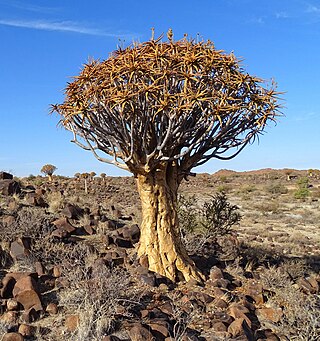
Aloidendron dichotomum, formerly Aloe dichotoma, the quiver tree or kokerboom, is a tall, branching species of succulent plant, indigenous to Southern Africa, specifically in the Northern Cape province of South Africa, and parts of Southern Namibia.
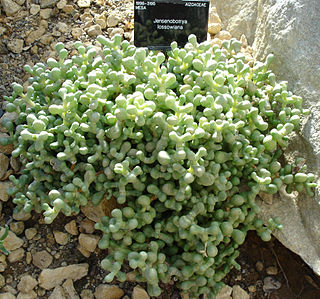
Jensenobotrya lossowiana is the only species of genus Jensenobotrya, in the family Aizoaceae. It is a succulent plant endemic to Namibia. Its natural habitat is rocky areas. It grows at Dolphin Head in Spencer Bay where it obtains moisture from the saline mists. It is threatened by habitat loss.
Felicia gunillae is a species of plant in the family Asteraceae that is endemic to Namibia.
Crassothonna clavifolia is a species of flowering plant in the family Asteraceae. It is found only in Namibia. Its natural habitat is rocky areas. It is threatened by habitat loss.
Aloe viridiflora is a species of plant in the genus Aloe. The species is endemic to Namibia with a wide range and is known from at least six different populations. Current trends are not known and the species is listed as LC on the IUCN Red List. However, it is scarce and Namibian authorities consider it threatened; the plant must not be removed or disturbed. It is the only known green-flowering aloe. Its natural habitats are dry savanna, subtropical or tropical dry shrubland, and rocky areas. It can produce hallucinations when ingested, leading to its occasional use in shamanic rituals.
Antimima eendornensis is a species of plant in the family Aizoaceae. It is endemic to Namibia. Its natural habitats are subtropical or tropical dry shrubland and rocky areas. It is threatened by habitat loss.
Mesembryanthemum namibense, synonym Brownanthus namibensis, is a species of flowering plant in the family Aizoaceae. It is endemic to Namibia. Its natural habitat is rocky areas. It is threatened by habitat loss.
Mesembryanthemum tomentosum, synonyms including Brownanthus pubescens, is a species of plant in the family Aizoaceae. It is native to the Cape Provinces and Namibia. Its natural habitats are dry savanna and rocky areas.
Cephalophyllum confusum is a species of plant in the family Aizoaceae. It is endemic to Namibia.

Juttadinteria deserticola is a species of plant in the family Aizoaceae that is native to Namibia and South Africa.

Juttadinteria is a genus of plants in the family Aizoaceae.
Juttadinteria ausensis is a species of plant in the family Aizoaceae that is endemic to Namibia.
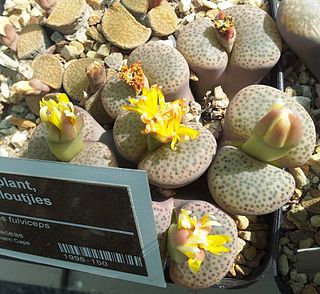
Lithops fulviceps is a species of plant in the family Aizoaceae. It occurs in a small region of southern Namibia and northern South Africa. Its natural habitats are rocky areas and cold deserts. It is threatened by habitat loss.
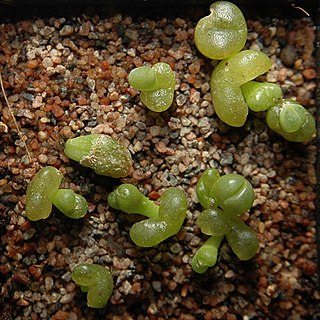
Lithops optica is a species of plant in the family Aizoaceae, endemic to Namibia.
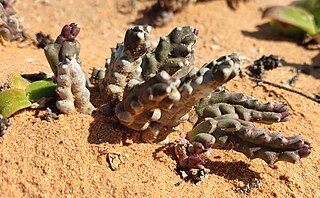
Tridentea pachyrrhiza is a species of plant in the family Apocynaceae that is native to Namibia and South Africa.

Aloe pearsonii is a very distinctive and unusual species of aloe, that is naturally endemic to the arid Richtersveld area on the border between South Africa and Namibia.

Lithops francisci, commonly known as one of the living stones or pebble plants, is in the family Aizoaceae. It is endemic to the arid desert environments of Namibia. It is a succulent with a natural habitat in rocky areas. L. francisci was assessed by Nicholas Edward Brown in 1925. It is one of the Lithops plants and shares the characteristic bi-leaf head pattern separated by a deep fissure, the bottom of which houses and protects the stunted stem.

Conophytum bilobum is a plant in the family Aizoaceae, native to southern South Africa. It blooms in autumn. It is scentless and grows to a height of 7 cm (2.8 in). The specific epithet bilobum comes from the two-lobed bodies these plants possess.
Stayneria is a genus of flowering plants belonging to the family Aizoaceae. It contains a single species, Stayneria neilii. It is in the subfamily Ruschioideae and the tribe Ruschieae.










